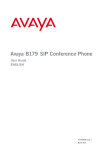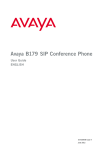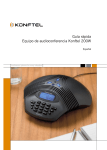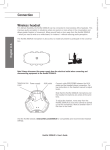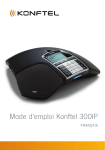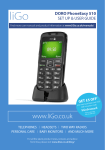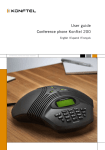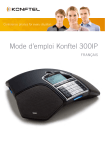Download Konftel 300IP Full Duplex - User Manual
Transcript
KONFTEL 300IP SET UP & USER GUIDE Find more user manuals and product information at www.liGo.co.uk/manuals/ OFF GET £5 over £50 * se t purcha your nex r code: e h c with vou www.liGo.co.uk ard liGo5rcoenjunwction * Not in with any TELEPHONES | HEADSETS | TWO WAY RADIOS PERSONAL CARE | BABY MONITORS | AND MUCH MORE For all the latest product news, reviews and advice from liGo, please visit www.liGo.co.uk/blog/ er other off The Konftel 300IP User Guide ENGLISH OmniSound® HD – Optimal sound By incorporating full duplex audio, the patented audio technology OmniSound® guarantees the audio conference an impressive and crystal clear sound in both directions through a hypersensitive microphone with 360° sound pickup and speakers that provide powerful sound distribution to all participants. OmniSound® HD offers HD audio transmission for VoIP calls. In addition features like echo cancellation, background noise suppression which minimizes distracting background noise and an equalizer for personal adjustment of the sound’s various characteristics are also included. Move freely around the room, talk, discuss and debate while retaining great sound quality that is entirely free from irritating sound clipping, damping or echoes. It’s as close as you can get to natural sound. Konftel AB hereby declares that this conference unit complies with all essential requirements and other relevant provisions of Directive 1999/5/EC. See www.konftel.com/doc for a complete declaration. Warning! do not expose the Konftel 300IP to rain or moisture. Warning! Do not open the case on the Konftel 300IP. 2 TABLE OF CONTENTS Description2 Conference guide General................................................... 2 Maintenance........................................... 2 Connections............................................ 2 Keypad................................................... 4 Display screen......................................... 5 Navigation and selection in menus............ 6 Making conference group calls.................21 Displaying conference group participants. 22 Adding a conference group..................... 22 Editing a conference group..................... 22 Deleting a conference group................... 23 Deleting all conference groups................ 23 Displaying conference guide status.......... 23 Answering and making calls 8 Recording24 Answering calls....................................... 8 Answering calls on hold............................ 8 Making calls............................................ 8 Redialling............................................... 8 Calling from the phonebook...................... 9 During a call Starting a recording................................24 Mute function.........................................24 Hold......................................................24 Ending a recording..................................24 Listening to a recording.......................... 25 Editing the name of a recording.............. 25 Deleting a recording............................... 26 Deleting all recordings............................ 26 Adjusting the recording indicator............. 26 Displaying recording feature status.......... 26 10 Adjusting the speaker volume...................10 Placing calls on temporary hold................10 Ending calls...........................................10 Secure connection..................................10 Making multi-party calls 11 Settings27 Adding another party to a call..................11 Making conference group calls.................11 Managing phone lines Basic settings....................................... 27 Advanced settings................................. 29 Settings during a call............................. 30 System..................................................31 Checking status..................................... 32 12 Selecting account when dialling ..............12 Switching between lines during multiparty calls..............................................13 Cutting a line.........................................14 Transferring calls....................................14 Using the web interface 34 Checking network addresses................... 34 Logging in to the Konftel 300IP.............. 35 Managing the phonebook........................ 36 Managing the conference guide............... 39 Checking the call list...............................41 Basic settings....................................... 42 Restarting the Konftel 300IP.................. 44 Checking status..................................... 45 Profiles15 Using a user profile.................................15 Changing the profile name and password..16 Phonebook17 Searching for contacts............................17 Adding contacts.....................................17 Editing contacts.....................................17 Deleting contacts....................................18 Deleting all conference groups.................18 Displaying phonebook status....................18 External phonebook (LDAP) 21 19 Search for and call a contact.................. 20 1 IP, SIP, URI and IP telephony 46 Technical specifications 48 Service and guarantee 50 DESCRIPTION GENERAL The Konftel 300IP is a conference phone for IP telephony offering a host of innovative features: • OmniSound® HD audio technology • IP telephony for flexible and affordable telephony • Option of using two accounts simultaneously • Conference feature for automatic multi-party dialling. • Management of lines during a call (dialling new parties, creating a multi-party call, splitting a multi-party call) • Recorder capability • Web interface for simple management of contacts, conference groups and settings • Extra microphone connection for wider reception (option) • Connection for wireless headset or PA system (option) • Future-proof, can be upgraded with smart functions. • Two-year guarantee. The Konftel 300IP is a future-proof product that is constantly evolving with smart new features. MAINTENANCE Clean the equipment with a soft, dry cloth. Never use liquids. CONNECTIONS Please refer to the “Konftel 300IP Installation Guide” for instructions on how to connect and register your conference phone. 2 DESCRIPTION Speaker Microphone Display screen Keypad LEDs SD memory card port LEDs Flashing blue Incoming call Steady blue light Call in progress Flashing red Hold, microphone and speaker turned off Steady red light Mute, microphone turned off Network cable port Expansion microphone port AUX port Security lock port Power supply port Expansion microphone port 3 DESCRIPTION KEYPAD Navigation in menus Display of call list Menu Settings Navigation in menus Display of call list OK Yes/confirm choice No/end/back Start/stop recording Answer/connect calls and Flash During a call: Press to call a new person Increase volume Decrease volume Hang up/end call Mute, the caller cannot hear you Hold, puts a call on hold Alphanumerical buttons Hold down a button for 2 seconds to open the phonebook Conference Automatic dialling of conference groups One press of this button will always connect all parties to a conference call Line selection Writing text Each button contains letters and characters - more than those shown on the button (see illustration below). Press the same button repeatedly to change to another character. If there are two letters under the same button that you want to enter one after the other, you need to pause slightly before entering the second letter. Press to delete the last character you entered. (blank) . - 1 A B C Å Ä Á À 2 D E F É È 3 G H I 4 J K L 5 M N O Ö Ø Ñ 6 P Q R S 7 T U V Ü Ú 8 W X Y Z 9 0 4 DESCRIPTION DISPLAY SCREEN On Hook Press to display this screen. Date Time Display text (can be changed) Registered Not registered Account name (can be changed) Off Hook Press to display this screen. Call duration Time Information text (see below) Phone lines (L1–L4) Line status (see below) Secure connection (see page 10) Line status: Line free (Before account name – telephone not registered) Line connected (Before account name – telephone registered) Line on hold (“HOLD” displayed on the screen – all calls on hold) Line (called party) busy Own line put on hold by other party Recording call Secure connection Information text displays one of the following: • Number or name of each phone line (The name will be displayed if a number is in the phone book) • Explanation of what you should do (For example ENTER NUMBER) • Status (For example HOLD when you place all calls on hold) 5 DESCRIPTION Line menu Press to switch to and from this menu. Line/number/name New line (two lines if two accounts are registered) Option for creating or splitting conference calls Menu Press to switch to and from a menu. Current menu Submenu Marked option – open by pressing OK button Scrolling list (indication of where the marked option is in the list or menu) List of setting options: Existing settings Marked option – select by pressing OK button List of names: Marked name – select by pressing OK button NAVIGATION AND SELECTION IN MENUS Press . Select the option you want from the menu using the arrow buttons. Confirm by pressing OK to select the marked option. Cancel the setting or go back one level in the menu by pressing . Quit the menu by pressing again. Note that after you have made changes to a setting, you must press OK to activate the setting. It is possible to open a menu option directly by pressing the number button that corresponds to the position of the option in the menu (e.g. 2 to open PHONE BOOK and then 3 to select EDIT CONTACT). 6 6 DESCRIPTION Writing style in instructions In the instructions, Press > SETTINGS (6) means you should: . Mark the SETTINGS option using the arrow buttons and confirm by pressing OK to open the menu (or press button number 6). Correspondingly, Phone book > Conference Guide in the web interface means you should select Menu Phone book and the Conference Guide tab. Menu tree 1 2 3 4 5 6 7 8 PROFILES PHONE BOOK EXT. PHONE BOOK CONF GUIDE RECORDING SETTINGS SYSTEM STATUS DEFAULT SEARCH CONTACT SEARCH GROUP PLAYBACK FILE BASIC PROFILE 1 ADD CONTACT ADD GROUP RENAME FILE ADVANCED PROFILE 2 EDIT CONTACT EDIT GROUP ERASE FILE PROFILE 3 ERASE CONTACT ERASE GROUP ERASE ALL PROFILE 4 ERASE ALL ERASE ALL SETTINGS STATUS STATUS STATUS BASIC SETTINGS RESTART ACCOUNTS REBOOT NETWORK FACTORY RESET NAT TRAVERSAL MEDIA ACCOUNTS TIME LANGUAGE DEVICE KEY TONE RING LEVEL EQUALIZER AUX PORT PA TIME FORMAT SCREEN TEXT DEFAULT The simplest way to make settings and edit contacts is using a PC and the Konftel 300IP web interface (see page 34). 7 7 ANSWERING AND MAKING CALLS ANSWERING CALLS A ring tone is heard and the blue LEDs start flashing. Press to answer. The LEDs show a steady blue light. ANSWERING CALLS ON HOLD If a call is made to the conference phone during another call, you will hear a double tone, INCOMING CALL will be displayed on the screen and the blue LEDs start flashing. Press to answer. The original call will automatically be put on hold. Press the Press (Conference) button to connect the calls. to end the new call and Use the line mode to reconnect the original call. (See page 13) to switch between the calls. MAKING CALLS See “MANAGING PHONE LINES” on page 12 about selecting an account before dialling. Dial the number. Press . The number is called and the LEDs show a steady blue light. The duration of the call is shown on the display screen. Or: Press . Dial the number and press OK to confirm. The number is called and the LEDs show a steady blue light. The duration of the call is shown on the display screen. REDIALLING Press an arrow button. The last number that you dialled appears on the display screen. Use the arrow buttons to scroll through the call list. Press . The number you have selected is dialled. You can delete the call list by scrolling to the end of the list and pressing OK when the question “CLEAR LIST?” appears. 8 ANSWERING AND MAKING CALLS CALLING FROM THE PHONEBOOK Please turn to page 17 for instructions on adding and updating contacts in the phonebook. Press and hold down a number button for two seconds. The phonebook appears on the display screen. The pre-programmed names appear in alphabetical order, starting with the number button’s first letter. Use the arrow buttons to mark the name in the phonebook. Press . The number you have selected is dialled. Konftel 300IP also supports an external phonebook in the form of a catalog server (LDAP server). Read more on page 19. 9 DURING A CALL ADJUSTING THE SPEAKER VOLUME Adjust the speaker volume using the buttons and . PLACING CALLS ON TEMPORARY HOLD Mute Press to turn off the microphone. The LEDs change from blue to red. The other party cannot hear what you are saying. Press to reconnect the call. Hold Press to put the call on hold. The LEDs change from blue to flashing red. Both the microphone and the speaker are turned off and the call is on hold. Press to reconnect the call. ENDING CALLS End the call by pressing . SECURE CONNECTION The Konftel 300IP supports secure data connections between devices (authentication and encryption). This feature must be activated by the administrator. You know the feature is activated if you see a closed padlock in the lower right-hand corner of the display screen when the Konftel 300IP has a secure connection to the other phone. If the phone or PBX you are calling does not support secure connections, you will see an open padlock on the screen. See the illustration on page 5. 10 MAKING MULTI-PARTY CALLS Turn to “MANAGING PHONE LINES” on the next page for instructions on putting an individual on hold during a multi-party call and other more advanced features. ADDING ANOTHER PARTY TO A CALL If there are free lines, new parties can be added, regardless of whether you have used the (Conference) button or if you are making a normal call. Press during the call to get a new dialling tone. Calls in progress are put on hold. Dial the new number. You can also press an arrow button to use the call list or use the menu to access the phonebook. Press the (Conference ) button to merge all lines into a multi-party call. MAKING CONFERENCE GROUP CALLS See “CONFERENCE GUIDE” on page 21 to create and edit conference groups. Press the (Conference) button. Select the conference group you want to call and press OK to confirm. The Konftel 300IP dials all the contacts in the group. The box in front of a person’s name fills as soon as that person answers. 11 MANAGING PHONE LINES SELECTING ACCOUNT WHEN DIALLING If you have more than one account registered in your Konftel 300IP, you can use the line mode to select the account that you want to use for the new call. Making a new call Press . The line menu with the name of your accounts is displayed. Select the account you wish to use for the new call and press OK or Dial the number and press OK to confirm. . Adding a party In the same way, a party can be added and an account selected for that party during a call. Press . The line menu with the name of your accounts (NEW:Xxx) and lines that are already busy will be displayed. Select the account you wish to use for the new call and press OK or . Other calls are put on hold. Dial the new number. Press the (Conference ) button to merge all lines into a multi-party call. 12 MANAGING PHONE LINES SWITCHING BETWEEN LINES DURING MULTI-PARTY CALLS Talking privately with one individual Press . All lines are put on hold. Alternatively, you can press after opening the line menu or you can select SPLIT CONFERENCE from the line menu to put the lines on hold. Press . The line menu is displayed. Mark a party in the line menu and press OK or . The party is reconnected to the call. Switching to another caller This assumes that you are talking with just one individual as described above. Mark another party in the line menu and press . The first party is put on hold and the other is connected to the call. Talking to several parties This assumes that you are talking with just one individual as described above. Mark another party in the line menu and press OK. Both the first and the second party are connected to the call. Talking to all parties Press (Conference). All parties are connected to the call. An alternative way to connect all lines to the call is to select MAKE CONFERENCE in the line menu. 13 MANAGING PHONE LINES CUTTING A LINE Individual lines can be cut out of a multi-party call. Press . The line menu is displayed. Mark the line you want to cut and press . TRANSFERRING CALLS If you wish to transfer a call to another telephone. Select > TRANSFER. Dial the number and press OK to confirm. The call is transferred to the other telephone. NB. Some PBXs do not support this option. 14 PROFILES The Konftel 300IP gives you the option of using a password to protect contact information in the phonebook and conference guide. All contacts entered by default can be accessed by all users and cannot be password protected. All contacts entered by Admin are also displayed in default mode. To enter personal contacts, conference groups and settings that are inaccessible to other users, select user profile and enter the PIN code for the profile. The four personal user profiles each hold up to 1000 contacts and 20 conference groups. Settings that are unique for each profile are: • Standard account (If two accounts are registered) • Language • Ringtone level • Keypad tone • Time format • Equalizer • Display text Contacts and other settings are managed in the same way if you log in with a user profile, except that the changes you make do not affect other users. Note the user profile name and PIN code can only be changed via the web interface. Admin is able to change all user profile names and PIN codes. USING A USER PROFILE Select > PROFILES (1). Mark the profile you want and press OK. Enter the PIN code for the profile. The default code is 0000. Logging out of the profile Select > PROFILES (1). Press OK with the LOGOUT option marked. 15 PROFILES CHANGING THE PROFILE NAME AND PASSWORD Log in to Konftel 300IP, see pages 34–35. Select Settings > Basic. Click on the Edit button under the heading Profiles. Enter a name and a new PIN code. Click on Set and save your settings by clicking on Save. Make a note of the name and PIN code and keep them in a safe place. The administrator is able to reset the settings. 16 PHONEBOOK The Konftel 300IP’s phonebook can hold up to 1000 numbers in each user profile. See page 8 for making calls via the phonebook. Please turn to page 4 for instructions on using the keypad to enter text. SEARCHING FOR CONTACTS The simplest way to search for a contact in the address book is to hold down an alphanumeric button for two seconds (see page 8). You can also search for a contact via the PHONEBOOK menu. Select > PHONE BOOK > SEARCH CONTACT. Mark the contact you want. You can use the arrow buttons to press an alphanumeric button to jump to the first name that starts with that letter in the list. Press OK or to dial the selected contact, to exit the menu. to return to the PHONEBOOK menu or ADDING CONTACTS Select > PHONE BOOK > ADD CONTACT. Enter the name of the contact and press OK to confirm. Write the number and press OK to confirm. Press OK to add another contact or to exit the menu. EDITING CONTACTS Select > PHONE BOOK > EDIT CONTACT. Mark the contact you want to change. Press OK to confirm. Make the change and press OK to confirm. Delete a number or a letter in a name by pressing . If you want to cancel the change you are making and leave the name or number as they were, press PHONEBOOK menu appears. 17 until the PHONEBOOK DELETING CONTACTS Select > PHONE BOOK > ERASE CONTACT (2,4). Mark the contact you want to delete and press OK. Confirm that you really want to delete the contact by pressing OK or cancel the deletion of a contact by pressing . DELETING ALL CONFERENCE GROUPS Select > PHONE BOOK > ERASE ALL (2,5). Confirm that you really want to delete all contacts by pressing OK or cancel the deletion of a contact by pressing . DISPLAYING PHONEBOOK STATUS Select > PHONE BOOK > STATUS (2,6). The display screen indicates the number of contacts already stored plus how many more contacts can be added. 18 EXTERNAL PHONEBOOK (LDAP) Konftel 300IP has support for an external phonebook. This means it can communicate with a catalog server according to LDAP (Lightweight Directory Access Protocol). To make the external phonebook accessible, an administrator must activate and configure the LDAP function in Konftel 300IP. An LDAP database can hold thousands of contacts and for this reason, Konftel 300IP includes a search function to filter the content of the database dynamically, based on the search characters you enter. The first three contacts that match your search Selected contact (Use the arrow keys to scroll the list) The search characters you entered The number of contacts in the database that match your search (If the > sign is visible before the number, it means that there are more contacts available but they are not shown) When you find the right contact, you can open it with OK. When you have done this, you can choose which of the contact’s telephone numbers you want to ring (for instance, work, mobile or home). List of telephone numbers for the selected contact Please note, the administrator has the option to configure the function in different ways; this means it may function differently to the way described here. The administrator can determine in which database field your search characters will be used, the number of hits that are to be displayed in Konftel 300IP and the information that is to be displayed (name, company, department, telephone number). Contact the company’s telephone or network manager for information on how LDAP is configured for your Konftel 300IP. 19 EXTERNAL PHONEBOOK (LDAP) SEARCH FOR AND CALL A CONTACT Select > EXT. PHONEBOOK (3). Konftel 300IP contacts the database, which sends all the contacts. The first 50 are shown in Konftel 300IP (with standard default settings). Enter one or more search characters to filter the list. The number of hits in the database is reduced for each character you enter. If the > sign is visible before the information on the number of hits, it means that there are more contacts available but they are not shown. Enter search characters, until the number of hits is low enough for you to find the contact you want easily. You can delete an incorrect character with the key . Please turn to page 4 for instructions on how to use the keypad to enter text. Mark the contact you want by using the arrow keys and open it by pressing OK. If you regret your search, you can press to return to the search results or to finish the search. Mark the number you want to dial (if several telephone numbers are displayed for the contact) and press OK or . The number you have selected is dialled. 20 CONFERENCE GUIDE The conference guide makes it easy to set up calls with as many as five people, including your own phone. The Konftel 300IP automatically dials all the contacts in the conference group. You can create 20 conference groups in each user profile. Entering text with the keypad Please turn to page 4 for instructions on using the keypad to enter text. MAKING CONFERENCE GROUP CALLS (Conference) button. Press the Select the conference group you want to call. You can use the arrow buttons to press an alphanumeric button to jump to the first name that starts with that letter in the list. Press OK if you want to see who is in the group before you make the call. (Then press OK again or to call.) Press directly if you want to make the call without first checking who is in the group. The Konftel 300IP dials all the contacts in the group. The box in front of a person’s name fills as soon as that person answers. You can also use the menu to search for and dial a conference group. Select > CONF GUIDE > SEARCH GROUP (4,1), select the conference group you want and confirm by pressing OK or in the same way as above. Adding another party to a call Press during the call to get a new dialling tone. Calls in progress are put on hold. Dial the new number. You can also press an arrow button to use the call list or use the menu to access the phonebook. Press the (Conference) button to connect the calls. 21 CONFERENCE GUIDE DISPLAYING CONFERENCE GROUP PARTICIPANTS Select > CONF GUIDE > SEARCH GROUP (4,1). Mark the group you want and press OK. The names of the conference group participants are displayed. Press OK or to return to the CONFERENCE GUIDE menu or to dial the group. to exit the menu. Press ADDING A CONFERENCE GROUP Select > CONF GUIDE > ADD GROUP (4,2). Enter a group name and press OK to confirm. Press OK to enter the first person. Write the name of the first person and press OK to confirm. Enter the number and press OK to confirm. Press OK to add another person and repeat the above steps. Conclude by pressing . EDITING A CONFERENCE GROUP Select > CONF GUIDE > EDIT GROUP (4,3). Here, you can change the name of a conference group, add or delete a person from a group and change a person’s name and phone number. Mark your choice of option in the menu using the arrow buttons and press OK to confirm. The names of the conference groups are displayed. Mark the group you want to change and press OK to confirm. Mark a person you want to change and press OK to confirm. Make the change and press OK to confirm. Delete a number or a letter in a name by pressing . If you want to cancel the change you are making and leave the name or number as they were, press CONFERENCE GUIDE menu appears. 22 until the CONFERENCE GUIDE DELETING A CONFERENCE GROUP Select > CONF GUIDE > ERASE GROUP (4,4). Mark the group you want to delete and press OK. Confirm that you really want to delete the group by pressing OK or cancel the deletion of a group by pressing . DELETING ALL CONFERENCE GROUPS Select > CONF GUIDE > ERASE ALL (4,5). Confirm that you really want to delete all groups by pressing OK or cancel the deletion of all groups by pressing . DISPLAYING CONFERENCE GUIDE STATUS Select > CONF GUIDE > STATUS (4,6). The display screen indicates the number of conference groups already stored plus how many more groups can be added. 23 RECORDING It is possible to record a phone conference on an SD (Secure Digital) memory card so you can listen to it later on. It is possible to record a call in progress and use the Konftel 300IP as a dictaphone. Konftel 300IP supports SD and SDHC cards and the recording capacity is 35 hours per GB. A flashing symbol appears on the display screen during recording. A beep is heard every 20 seconds so that other parties in the call know it is being recorded. The beep can be turned off (see page 26). The recorded call is saved on the memory card. The document is named after the time at which the recording began (e.g. 14-35-01.wav) and is saved in a folder with the current date. This name can be changed after the recording has ended. STARTING A RECORDING Remember to notify all parties in the call before you start recording. Press the button for two seconds and press OK to confirm. The recording symbol flashes on the display screen. MUTE FUNCTION Press the button during a call to turn the microphone off. The LEDs change from blue to red. The other party cannot hear what you are saying and only the called party is recorded. HOLD Press during the call to put the call on hold. The LEDs change from blue to flashing red. Both the microphone and the speaker are turned off and the call is on hold. None of the parties will now be recorded. ENDING A RECORDING Press the button for two seconds and press OK to confirm. The recording symbol is no longer displayed on the screen. If you are recording a call and the call is ended, you will be asked if you want to stop recording. 24 RECORDING LISTENING TO A RECORDING You can listen to a recorded phone conference on your Konftel 300IP or a computer using an SD memory card reader. Recordings are saved in wav format and can be played back on your choice of media player. Listening to recordings on the Konftel 300IP: Select > RECORDING > PLAYBACK FILE (5,1). Mark the folder you want (date) and press OK to confirm. A list of all recordings for the specified date is displayed. Names, date, time and length are displayed for each recording. Mark the recording you want and start the playback by pressing OK. Adjusting the speaker volume Increase the volume using the button and lower it using . Pause playback Pause the playback by pressing OK. Restart playback by pressing OK again. Move forward in the recording during playback Move forward in the recording by pressing arrow down or backward by pressing arrow up. The recording advances about 10 seconds every time you press the button. Stop playback Stop the playback by pressing . EDITING THE NAME OF A RECORDING The recording is named by default with the time at which the recording started. Select > RECORDING > RENAME FILE (5,2). Mark the folder you want and press OK to confirm. Mark the recording to be edited and press OK. Make the change and press OK to confirm. Delete a number or a letter in a name by pressing . If you want to cancel the change you are making and leave the name or number as they were, press several times until the RENAME FILE menu appears. 25 RECORDING DELETING A RECORDING Select > RECORDING > ERASE FILE (5,3). Mark the folder you want and press OK. Mark the recording to be deleted and press OK. Confirm that you really want to delete the recording by pressing OK again, or cancel the deletion of a recording by pressing . DELETING ALL RECORDINGS Select > RECORDING > ERASE ALL (5,4). Confirm that you really want to delete all recordings by pressing OK again, or cancel the deletion of a recording by pressing . ADJUSTING THE RECORDING INDICATOR A short beep is heard every 20 seconds so that all the parties in the call know it is being recorded. This feature can be turned off. Select > RECORDING > SETTINGS (5,5). Select your choice and press OK to confirm. DISPLAYING RECORDING FEATURE STATUS Select > RECORDING > STATUS (5,6). The display screen indicates the number of recordings, the total length of recorded calls and how many hours of recording time are left before the memory card is full. 26 SETTINGS The Konftel 300IP has two groups of settings: Basic and Advanced. You must enter the Admin. PIN code to access the advanced settings. The simplest way to make settings is using a PC and the Konftel 300IP web interface (see page 34). BASIC SETTINGS Select default account If the phone has two registered accounts, you can choose one of them as default. Select > SETTINGS > BASIC > ACCOUNTS (6,1,1). Select ACCOUNT 1 or ACCOUNT 2 and press OK to confirm. The account name is displayed. NOT CONFIGURED will be displayed if the selected account is not registered. Selecting languages Select > SETTINGS > BASIC > LANGUAGE (6,1,2). Select the language you want and press OK to confirm. Deactivating keypad tones You can select whether or not you want a tone to be heard when you press a button. Note that this setting does not affect the tone you hear when you dial a number in call mode. Select > SETTINGS > BASIC > KEY TONE (6,1,3). Select your choice and press OK to confirm. Adjusting ring level volume Select > SETTINGS > BASIC > RING LEVEL (6,1,4). Select your choice and press OK to confirm. There are six volume levels plus a silent mode. You will hear the ring tone for each level you select. If you select silent mode, an LED on the phone flashes when an incoming call is received. Adjusting sound (equalizer) The sound reproduction can be adjusted to the required pitch (SOFT, NEUTRAL and BRIGHT). Select > SETTINGS > BASIC > EQUALIZER (6,1,5). Select your choice and press OK to confirm. 27 SETTINGS Settings when connecting external equipment (Aux) The Konftel 300IP can be connected to a wireless headset or an external PA system. An optional PA interface box is required for PA system connection. Select > SETTINGS > BASIC > AUX PORT (6,1,6). Select the PA option to activate features for external microphone mixer and PA system. Do not select the PA option unless a PA system is connected. This option turns off the internal microphone and internal speakers. The HEADSET option may be selected whether or not a headset is connected. Settings for external PA system It is assumed that the PA option has been activated in the previous menu before making these settings. Select > SETTINGS > BASIC > PA (6,1,7). Select INTERNAL MIC and press OK to switch between on (shaded box) and off. To ensure maximum audio quality, do not use the internal microphone and external microphones connected via the PA interface box at the same time. Only the internal microphone is turned off. Any external microphones connected to the Konftel 300IP are still turned on. Select INTERNAL SPKR and press OK to switch between on (shaded box) and off. To ensure maximum audio quality, do not use the internal speakers and external speakers connected via the PA interface box at the same time. Time format The date and time can only be set by Admin. The time is normally retrieved from a time server. The time format has 12-hour and 24-hour options. Select > SETTINGS > BASIC > TIME FORMAT (6,1,8). Select your choice and press OK to confirm. 28 SETTINGS Changing text on the display screen The text on the display screen can be changed when the Konftel 300IP is on hook. Select > SETTINGS > BASIC > SCREEN TEXT (6,1,9). Delete existing text using and enter your new text. Press OK to confirm. Resetting This resets all user settings for the user profile shown to factory default settings. The phonebook, conference guide and all basic settings are reset. Account, network and SIP settings are not reset. Select > SETTINGS > BASIC > DEFAULT. Confirm that you really want to reset the settings to default by pressing OK again, or cancel the resetting procedure by pressing . ADVANCED SETTINGS Only Admin. is able to make these settings. See “Installation and Administration of Konftel 300IP”. 29 SETTINGS SETTINGS DURING A CALL The HEADSET/PA, PHONE BOOK, TRANSFER and EQUALIZER menus may be accessed during a call and are displayed when the button is pressed. The first option is either HEADSET or PA depending on whether PA is activated or not. These HEADSET/PA settings can only be accessed when a call is connected. Turn off the internal speakers when using a headset PA should not be activated when using the HEADSET menu option. A wireless headset can be used if a person needs to move far away from the conference phone (e.g. during a seminar or presentation). The internal speakers can be turned off temporarily if you wish to use the Konftel 300IP as a personal telephone with a headset. Select > HEADSET. Select YES when asked “SPEAKER OFF?”. The speakers come on automatically when the call is ended. Adjusting microphone volume from PA system PA should be activated when using the PA menu option. Select > PA > PA MONITOR. Adjust the microphone volume from the mixer so that the level on the display screen is around 10–12 when speaking in a normal tone. Adjusting PA calibration manually It is possible to calibrate the duplex performance of the conference phone when it is connected to a PA system. The calibration level can be set automatically by the Konftel 300IP or adjusted manually to any value between 0 and 5 (0 being full duplex). • Increase the calibration if the remote party experiences disturbing echoes. • Decrease the calibration if the remote party experiences low duplex, i.e. your voice is muted or clipped when the other party is speaking. The position of the PA system’s microphones and speakers and the amplifier’s settings may affect full duplex performance. Select > PA > CALIBRATION. 30 SETTINGS AUTO is the default setting and is recommended in most cases. The figure shown in brackets is the measured calibration value. Select different levels and compare the audio quality to achieve your preferred setting. NB. You must ask the person you are calling to assess the effect of the adjustments you make. SYSTEM The system menu can be used for manual restarts and resets. Restarting the phone programme This restarts the phone, which takes about two minutes. Select > SYSTEM > RESTART (7,1). Confirm that you really want to restart by pressing OK again, or cancel the restart by pressing . Restarting the phone This restarts the telephone application, which takes less than 30 seconds. Select > SYSTEM > REBOOT (7,2). Confirm that you really want to restart by pressing OK again, or cancel the restart by pressing . Restore to factory settings This option fully restores the Konftel 300IP to factory settings. All settings are deleted, including PIN codes and registered accounts. Alternatively, a PIN code is required for Admin. Select > SYSTEM > FACTORY RESET (7,3). Enter the PIN code for Admin and press OK. Confirm that you really want to restart by pressing OK again, or cancel the restart by pressing . 31 SETTINGS CHECKING STATUS The status menu can be used for troubleshooting. Only the administrator is able to change these settings. See “Installation and Administration of Konftel 300IP” for an explanation of the settings. Account 1 To check account settings for SIP account 1. Select > STATUS > ACCOUNTS > ACCOUNT 1 (8,1,1). This shows the status for: - ACCOUNT NAME - STATUS - REGISTRAR - SIP ID - AUTH.NAME - REALM - PROXY Account 2 To check account settings for SIP account 2. Select > STATUS > ACCOUNTS > ACCOUNT 2 (8,1,2). Shows the same information as the menu option above. Transfer protocol To check which protocol is used to transmit data packages over the network. Select > STATUS > ACCOUNTS > TRANSPORT (8,1,3). Current protocol is displayed. Network To check which protocol is used to transmit data packages over the network. Select > STATUS > NETWORK (8,2). This shows the status for: - DHCP - IP ADDRESS - HOSTNAME - DOMAIN - NETWORK - GATEWAY - DNS 1 - DNS 2 - VLAN 32 SETTINGS NAT Traversal To check whether address conversion is activated, which may be necessary if the phone is behind a firewall. Select > STATUS > NAT TRAVERSAL (8,3). This shows the status for: - STUN - TURN - ICE Media To check priorities of audio codecs and DTMF signalling. Select > STATUS > MEDIA (8,4). This shows the status for: - CODEC PRIORITY - VAD - DTMF SIGNALLING - SECURITY RTP - SECURE SIGNALLING Time To check time servers and time zones. Select > STATUS > TIME (8,5). This shows the status for: - NTP - NTP SERVER - TIMEZONE Equipment To check the phone’s serial number and software version. Select > STATUS > DEVICE (8,6). This shows the status for: - KONFTEL 300IP (software version and date) - SERIAL NUMBER - MAC ADDRESS 33 USING THE WEB INTERFACE You can use the web browser of a PC connected to the same network to manage contacts, conference groups and settings in the Konftel 300IP. Your choice of language for the Konftel 300IP does not affect the web interface, which is only in English. For security reasons, recordings can only be managed directly on the Konftel 300IP. All other settings that can be made directly on the Konftel 30IP can also be made via the web interface. It is also possible to import and export contacts and conference groups, name user profiles and change PIN codes, which can only be done via the web interface. The administrator can also view logs, update software and create a configuration file. Settings for accounts and networks require you to log in as an administrator. However, you can always check all settings as a user. Settings that require administrator rights are listed in the “Konftel 300IP Installation Guide” and “Installation and Administration of Konftel 300IP”. The default setting for the PIN code is 0000 for the user account (Default, Profile 1, Profile 2, Profile 3 and Profile 4). We recommend that you change the PIN codes in order to protect the settings. The code may consist of eight digits. The administrator can always view and change the PIN codes to the user accounts. The administrator’s PIN code can only be reset with a complete reset to factory settings. CHECKING NETWORK ADDRESSES You must use the network address to log into the web server in the Konftel 300IP. Press and select the menu option STATUS > NETWORK (8,2). Check the conference phone’s network address under the heading IP ADDRESS. 34 USING THE WEB INTERFACE LOGGING IN TO THE KONFTEL 300IP Enter the phone’s network address in the web browser address bar. Select Default or an empty user profile in Profile and enter the PIN code. The default code is 0000. You can create a personal password-protected phonebook using a user profile. 35 USING THE WEB INTERFACE MANAGING THE PHONEBOOK Select Phone Book. Here, you can add, change and delete contacts. You can also import existing contacts. When you call or are called by a contact who is already in the phonebook, that person’s name is displayed on the screen. Adding a contact Enter the contact’s name under Name: Enter the contact’s phone number or URI under Number/URI. Information about URI can be found on pages 44–45. The way the number can be written may depend on the SIP PBX being used, but normally you can use: • Complete phone number, including country code • Phone number, including area code • Local phone number only • Internal speed dial number (with company’s own PBX) • URI, e.g. sip:[email protected] • URI with IP address, e.g. sip:10.10.1.100 (within a local network) Click on Add contact. 36 USING THE WEB INTERFACE Editing contacts Click on the Edit contact button after the contact you want to change. Edit the contact and click on Save contact. Deleting contacts Click on the Erase contact button after the contact you want to delete. Confirm that you want to delete the contact. You can also delete all contacts by pressing the Erase all button. Importing contacts You can import contacts from a comma separated values (CSV) file. One way of creating a CSV file is using Microsoft Excel and saving the file in CSV format. Enter the names of the contacts in the first column and their phone numbers or URIs in the second. Do not use hyphens or spaces in the number. Note that Excel ignores zeros at the beginning of numbers. The cells must therefore be formatted as text. Information about URI can be found on pages 46–47. CSV files can also be created using software that can save in unformatted text format. Write a name, followed by a semi-colon and number – one contact on each line. When you save the file, give it a csv extension instead of txt. 37 USING THE WEB INTERFACE It is normally possible to export contact books stored in your PC in CSV format. Click on the Scroll… button under the heading Import in the web window. Open your CSV file. Click on Import. The name is limited to 15 characters, since the Konftel 300IP screen cannot display more than 15 characters. Exporting contacts You can export your contacts as a CSV document in order to import them into another phone. Click on Export. Save the document. 38 USING THE WEB INTERFACE MANAGING THE CONFERENCE GUIDE Select Phone Book > Conference guide. Here, you can add, change and delete conference groups. It is also possible to import groups that you have created. When a call is connected to a contact who is already in the phonebook, that person’s name is displayed on the screen. Adding a conference group Give the group a name, enter the names and phone numbers of the group members. You can also add participants from the phone book by clicking the drop-down list Phone book. Save the group by clicking on Add group. Editing a conference group Click on Edit group next to the contact you want to change. Edit the group and click on Save group. 39 USING THE WEB INTERFACE Deleting a conference group Click on the Erase group button next to the group you want to delete. Confirm that you want to delete the group. You can also delete all groups by pressing Erase all groups. Importing conference groups You can import conference groups using a comma separated values (CSV) file. See “Importing contacts” on page 37 for more information. Enter the name of the group in the first column, the names of the group members in the second and their phone numbers or URIs in the third. Click on the Scroll… button under the heading Import in the web window. Open your CSV file. Click on Import. Exporting conference groups You can export your groups as a CSV document in order to import them into another phone. Click on Export. Save the document. 40 USING THE WEB INTERFACE CHECKING THE CALL LIST Incoming, outgoing and missed calls are displayed in the call list in chronological order. Select Call list > Recent. Select one of the tabs Incoming, Outgoing or Missed to filter the list. 41 USING THE WEB INTERFACE BASIC SETTINGS The settings only affect the user profile you selected when you logged in. Select Settings > Basic. Select Settings > Basic. Changing PIN code and profile name The PIN code can be changed from the default setting to protect against unauthorised use. Click on the Edit button under the heading Profiles. Enter a new PIN code. The code may consist of 8 digits. If you are changing a user profile, you can also change the name. Click on the Set and Save buttons. Make a note of the new PIN code and keep it in a safe place. The administrator is always able to view and change the name and PIN code of the profile. 42 USING THE WEB INTERFACE Select default account The Konftel 300IP can save settings for two accounts, e.g. a company PBX and a public IP telephony service provider. This setting determines which account should be used as default. You can select the account you want to use for a call by pressing number. before dialling the Select Account 1 or Account 2 under the heading Default account and click on Save. Selecting languages Select a language in the list under the heading Language and click on Save. Changing the ring tone level Select the tone level from the list under the heading Ring level and click on Save. Changing key tone Select On or Off under the heading Key tone and click on Save. Changing the recording indicator A short beep is heard every 20 seconds so that all the parties in the call know it is being recorded. This feature can be turned off. Select On or Off under the heading Recording tone and click on Save. Settings when connecting external equipment (Aux) The Konftel 300IP can be connected to a wireless headset or an external PA system. An optional PA interface box is required for PA system connection. Select the PA option to activate features for external microphone mixer and PA system. Do not select the PA option unless a PA system is connected. This option turns off the internal microphone and internal speakers. The HEADSET option may be selected whether or not a headset is connected. Changing the time format Select 12 hour or 24 hour under the heading Time format and click on Save. 43 USING THE WEB INTERFACE Adjusting the sound The sound reproduction can be adjusted to the required pitch (SOFT, NEUTRAL and BRIGHT). Select Soft, Neutral or Bright under the heading Equalizer and click on Save. Display text The display text appears on the screen when the Konftel 300IP is on hook. Enter the text in the text field and click on Save. RESTARTING THE KONFTEL 300IP Select Settings > System. Restarting the phone application This only restarts the phone software with the current settings. The restart takes about 30 seconds. Click on Restart. Restarting the phone This shuts down and restarts the phone. This restart takes about three minutes. Click on Reboot. 44 USING THE WEB INTERFACE CHECKING STATUS Although it is not possible to make settings in the Status menu, the information here may be useful when troubleshooting. Select Status. You can find the phone’s serial number, network port address and current software version on the Basic tab. Settings made by the administrator for the network, time server, SIP accounts and media are on other tabs. 45 IP, SIP, URI AND IP TELEPHONY IP stands for Internet Protocol and is the standard protocol for transferring information over the Internet between computers and other devices. The same standard is normally used in local networks too. An IP address is the unique network address that a computer has in the network. An IP phone is a phone that, like a PC, is connected to the network/Internet. Like the PC, it has an IP address and the call is transmitted as data packets over the network. Calls can be made from an IP phone to other IP phones (without leaving the network) and to regular phones over the public telephone network. SIP stands for Session Initiation Protocol and is a standardised protocol (communication regulations) for connecting phone calls via networks – in most cases via the Internet too. To make and receive calls, the phone has to be registered to an SIP switch. The switch can be a company PBX or be located with an IP telephony service provider. The SIP switch ensures that the call is connected to the right address within the network or sends the call to the public telephone network if the recipient is not registered as an IP telephone in the same switch. Making calls with IP phones When you use an IP phone to make a call to another IP phone within the network, the call does not usually cost anything. When you use an IP phone to make a call to a regular analogue phone, you normally pay the standard rate from the point at which the SIP switch connects the call to the telephone network. An IP phone can be moved and used all over the world. The only requirement is access to the Internet or, to be more accurate, access to the SIP switch where it is registered. Users must bear in mind that calls to analogue phones are connected to the telephone network where the switch is located. A company can make free calls to its offices in different countries provided it uses IP phones connected to the same SIP switch. If the SIP switch being used is in another country, it may be necessary to have two SIP accounts in the phone. One for the company’s internal IP calls and one for local external calls via the analogue telephone network. Otherwise there is a risk of making overseas calls to order a pizza from down the road. Phone numbers and network addresses An IP phone has a normal phone number plus a network address. When someone calls an IP phone number, the SIP switch converts the call into data packets that are sent over the network to the phone’s network address. You can make a call from an IP phone to another using the network address. When you send an email to someone, you don’t need to know the computer’s network address, and it’s the same when you make a call from an IP phone, you don’t need to know the IP phone’s network address. The address that you use instead is easier to understand, i.e. the phone’s e-address or public address. 46 IP, SIP, URI AND IP TELEPHONY These addresses are designed like email addresses, i.e. name@domain, for example [email protected]. A complete URI (Uniform Resource Identifier) is created when the protocol that is used to communicate with the resource is added to the address. A URI might look like this: sip:[email protected]. URIs can be used instead of phone numbers to make calls from one IP phone to another. 47 TECHNICAL SPECIFICATIONS Size Diameter 240 mm, height 77 mm Weight 1 kg Colour Liquorice black Display screen Illuminated graphics (LCD), 128x64 Keypad Alphanumerical 0–9, *, on, off, mute, hold, volume up, volume down, 5 buttons for menu navigation, line mode, conference guide Anti-theft protection Kensington security slot Memory Support for SD and SDHC memory cards Connectivity Network connection RJ45, Ethernet 10/100 Base T Power supply Transformer 100–240 V AC/13.5 V DC IEEE 802.3af Power over Ethernet, Class III. Extra microphones x2 modular 4/4 Auxiliary Modular 4/4 for wireless headset Network and communication Network addressing DHCP and static IP NAT traversal STUN, ICE and TURN Connection protocol SIP 2.0 (RFC 3261 and companion RFCs) Transport UDP, TCP, TLS and SIPS SecuritySRTP Audio support Codecs: G722, G711 A-law, G711 µ-law, G729ab DTMF tone generation RFC, SIP INFO, In-band Time servers NTP and SNTP Configuration Via integrated web server Sound TechnologyOmniSound® HD MicrophoneOmni-directional Reception area Up to 30 metres2, >10 people Speaker Frequency band 200–7000 Hz, Volume 90 dB SPL 0.5 m Equalizer Three pitches: soft, neutral, bright 48 TECHNICAL SPECIFICATIONS Environment Temperature: 5°–40°C Relative humidity: 20–80% condensation free Recommended acoustic conditions: Reverberation period: 0.5 S Rt 60 Background noise: 45 dBA 49 SERVICE AND GUARANTEE If anything is wrong with your Konftel unit, please contact the place of purchase. Guarantee We give a two-year guarantee on our conference telephones. Service Service is offered after the expiration of the guarantee. Please contact your retailer and ask for a cost estimate. Konftel support If you have any questions about the guarantee and service, please contact your Konftel support centre. Europe: +46(0)90-706 489 (Monday–Friday 8.00–17.00 GMT+1) E-mail: [email protected] USA and Canada: +1 866-606-4728 (Monday–Friday 08.00–17.00 GMT-8) E-mail: [email protected] 50 Konftel is a leading company and the world’s fastest growing brand, within audio conferencing equipment. Since 1988, our mission has been to help people around the world to conduct meetings despite distances. Based on our success, we know that audio conferencing is a great way to save time, money and at the same time contribute to a better environment. High audio quality is essential for efficient meetings, this is why our patented audio technology OmniSound®, is built into all Konftel Conference phones. The products are sold globally under the Konftel brand and our head-quarter is based in Sweden. Read more about the company and products on www.konftel.com Konftel AB, Box 268, SE-901 06 Umeå, Sweden Phone: +46 90 706 489 Fax: +46 90 131 435 E-mail: info@ konftel.com www.konftel.com 110048 Rev 5A



























































